Generative AI is transforming how consumers discover and engage with content, making it essential for brands to rethink and adapt traditional SEO strategies.
Leading this shift is generative engine optimization (GEO) – an evolution of SEO that leverages AI-driven insights to optimize content for visibility and authority across platforms like ChatGPT, Perplexity and Google’s AI Overviews.
This article will dive into the five key strategies to help you implement GEO effectively:
Let’s explore these strategies so you can boost engagement, increase visibility and achieve lasting success, positioning your brand as a leader in AI-driven search.
1. Generative AI research and analysis
Generative AI research is the foundation of your GEO strategy, focused on gathering insights to optimize your content and enhance visibility.
By knowing what your audience is looking for and how your brand matches up with AI algorithms focusing on relevance and authority, you can ensure your content meets their needs.
Let’s break down GEO research into these core components:
- GEO keyword research.
- AI Overview response analysis.
- Competitor research and analysis.
- Brand perception intelligence.
GEO keyword research
GEO keyword research identifies the keywords, queries and conversational phrases that AI-driven search engines prioritize.
AI algorithms favor content that mirrors natural language and comprehensively addresses user intent, so creating contextually rich, conversational content has become more essential than ever.
With over a billion voice searches occurring every month and 8.4 billion voice assistants expected to be in use by the end of the year, optimizing for natural language is no longer optional – it’s crucial.
By effectively leveraging GEO keyword research, you can ensure your content gives users what they’re looking for and aligns with AI preferences, enhancing user engagement and creating stronger connections with your audience.
Actionable tips:
- Understand your target audience:
- Start by gaining a deep understanding of what drives your audience’s searches – are they looking for information, products or solutions?
- Focus on the words, phrases and questions they use to craft content that effectively meets their needs.
- Identify relevant keywords, phrases and entities:
- Find keywords and phrases that resonate with your audience while aligning with AI’s focus on natural language processing:
- Long-tail keywords and conversational queries: Longer, more specific phrases that capture user intent and reflect natural, conversational search behavior.
- Semantic keywords: Related terms, synonyms or variations that add context and depth to your main keyword, making your content more meaningful and relevant.
- Entities: Recognizable people, places, things or specific concepts that enable AI to accurately categorize and reference your content.
- Contextually relevant phrases: Phrases that naturally occur within discussions around a topic and reinforce your content’s overall theme, helping AI understand the overall context of your content.
- Incorporating these elements into your content will help meet user needs while making it easier for AI to interpret and categorize effectively.
- Example: “best wireless headphones”
- Long-tail keywords: best wireless headphones under $200, best wireless headphones for working out, wireless headphones with long battery life
- Conversational queries: what are the best wireless headphones in 2024, which wireless headphones are best for noise cancellation?
- Semantic keywords: Bluetooth headphones, wireless earbuds, over-ear wireless headphones
- Entities: Apple, Bluetooth, Bose, Sony
- Contextually relevant phrases: crystal-clear sound quality, long-lasting battery, comfortable fit for all-day wear
- Example: “digital marketing strategies”
- Long-tail keyword: best digital marketing strategies in 2024, digital marketing strategies for small businesses
- Conversational query: what are the most effective digital marketing strategies, what type of marketing is best for small businesses
- Semantic keywords: digital marketing channels, digital marketing tips, online advertising strategies, inbound marketing strategies
- Entities: search engine optimization (SEO), content marketing, email marketing
- Contextually relevant phrases: grow your business, increase brand awareness, drive qualified traffic, reach your target audience
- Example: “best wireless headphones”
- Find keywords and phrases that resonate with your audience while aligning with AI’s focus on natural language processing:
- Explore SERP features and use AI tools:
- Explore SERP features: Use tools like Google’s “People Also Ask” and Autocomplete to find long-tail queries and related search terms. Tools like AlsoAsked can extract additional insights from this data.
- Leverage AI tools for topic research: Use platforms like ChatGPT to generate relevant concepts, phrases and queries. This will deepen your content’s relevance and align with AI’s understanding of the topic.
- Prompt example
- “Generate a list of long-tail keywords, conversational queries and contextually relevant phrases related to ‘[KEYWORD]’ that address different types of user intent (informational, navigational, commercial, transactional). Include common user queries, semantically related terms and key entities that should be emphasized to create comprehensive, user-focused content. Also, highlight areas where users often seek deeper insights, specific pain points or actionable solutions.”
AI Overview response analysis
AI Overview response analysis involves:
- Identifying the queries that trigger AI-generated overviews in Google.
- Understanding the prioritized topics and structures.
- Ensuring your brand is well-represented.
As these overviews grow in popularity and become the go-to choice for users seeking personalized, quick and concise answers, they are becoming critical touchpoints with the power to significantly influence your content’s visibility and credibility.
- Expanded visibility: AI Overviews are visible to all U.S. users, including those in incognito mode, offering broader visibility and new opportunities for content discovery. Google also expanded AI Overview availability to six new countries, increasing its global reach and potential impact on content visibility.
- Semrush AI Overview tracking enhancement: Semrush has enhanced its tracking for AI Overviews, simplifying large-scale analysis. While not all keyword data is fully integrated, the Organic Research report can help track the performance of queries triggering AI Overviews.
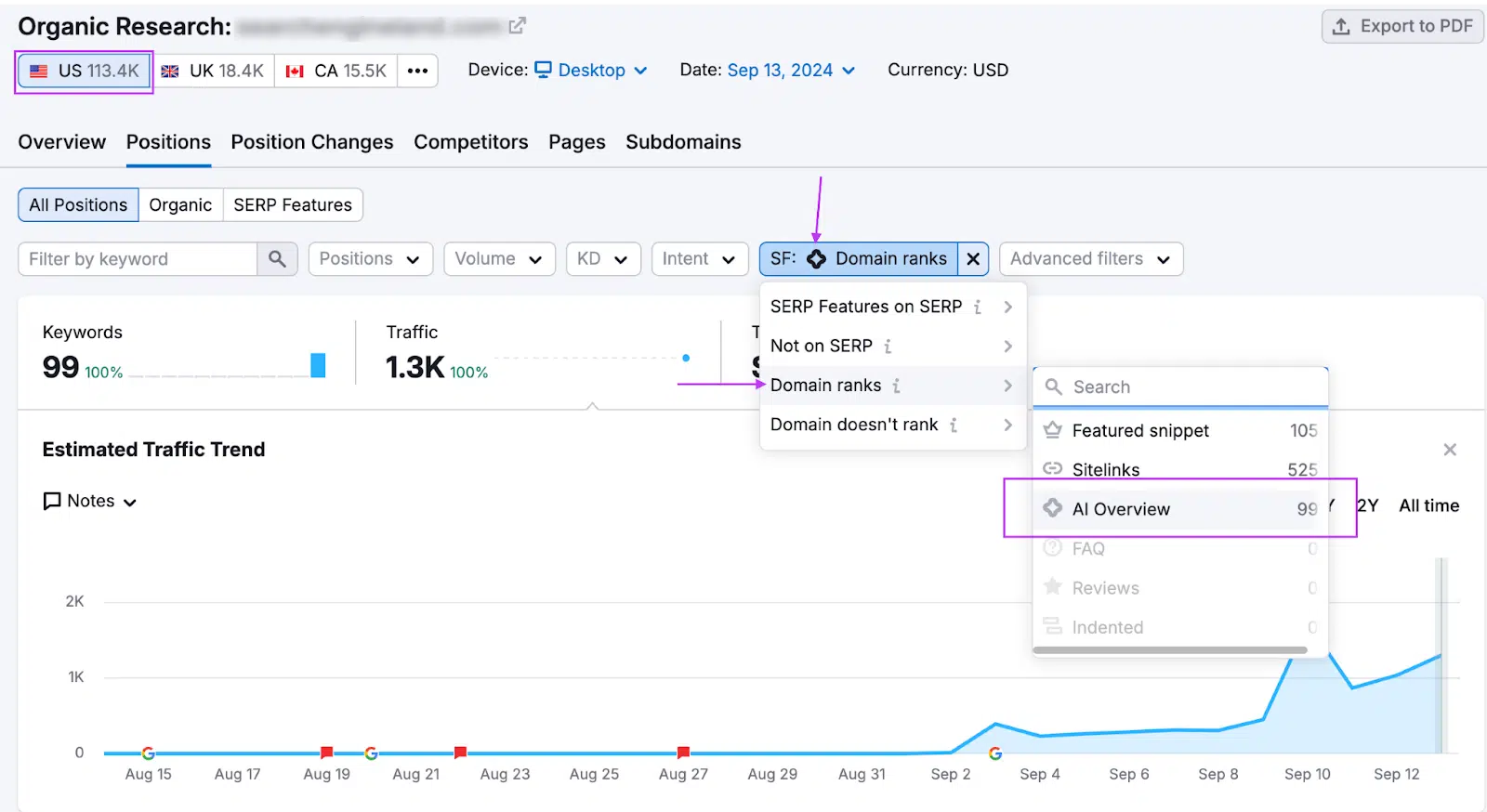

Actionable tips:
- Track your key queries triggering AI Overviews:
- Pinpoint the queries that trigger AI Overviews using a combination of tools to assess content performance and prioritize topics in your GEO strategy.
- Keyword rank tracking tools: Use tools like Semrush, BrightEdge and others to track keywords, keeping in mind that visibility may still be limited for less frequent triggers.
- Google Search Console: While it lacks direct AI Overview tracking, GSC provides valuable insights when used alongside other tools.
- Google Chrome extensions
- Google AI Overview Impact Analysis: This free extension tracks AI Overviews and cited sources across multiple keywords. You can export data, identify trends and refine your strategy.
- Google AI Overview Citation Analysis: Use this free extension to compare links cited in AI Overviews with traditional SERPs, allowing for side-by-side comparisons, competitor tracking and trend identification.
- Pinpoint the queries that trigger AI Overviews using a combination of tools to assess content performance and prioritize topics in your GEO strategy.
- Analyze your brand’s placement in AI Overviews:
- Ensure your content appears in AI Overviews for key queries, especially if it ranks well organically. AI doesn’t always pull from top-ranking SERP content, so being featured in overviews is essential for maintaining visibility.
- A recent seoClarity analysis by Mark Traphagen revealed that 99.5% of AI Overview citations now match one or more of the top 10 Google search results. However, the correlation can vary, making it essential to monitor regularly.
- Tip: Use a regex pattern with ChatGPT to filter top queries from a ranking export likely to trigger AI Overviews. As seen below, run these keywords through the AI Overview Impact Analysis extension to identify which queries generate overviews and the sources cited.
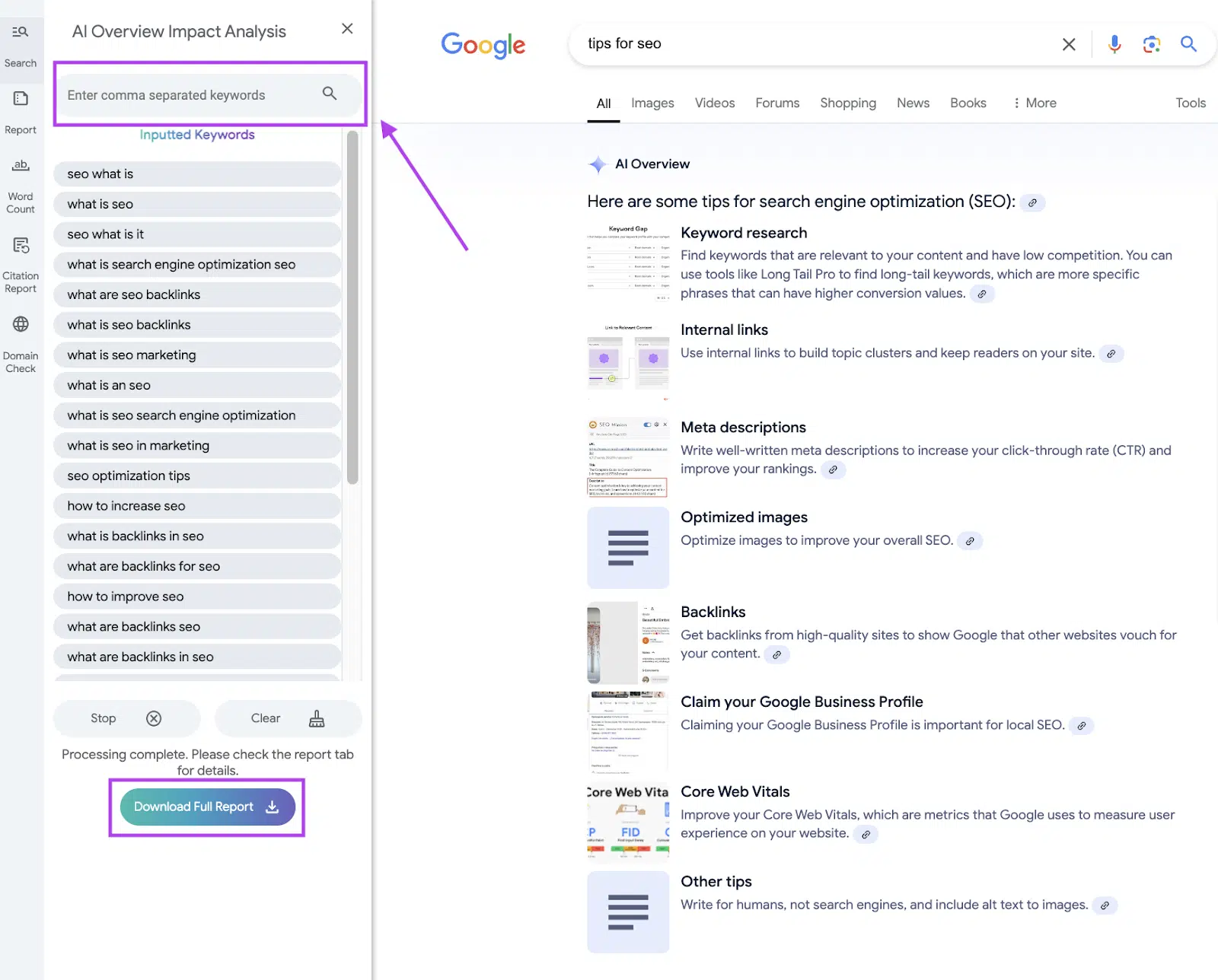

- By combining the downloaded report with your ranking data using VLOOKUP, you can effectively analyze AI Overviews in relation to your organic performance.
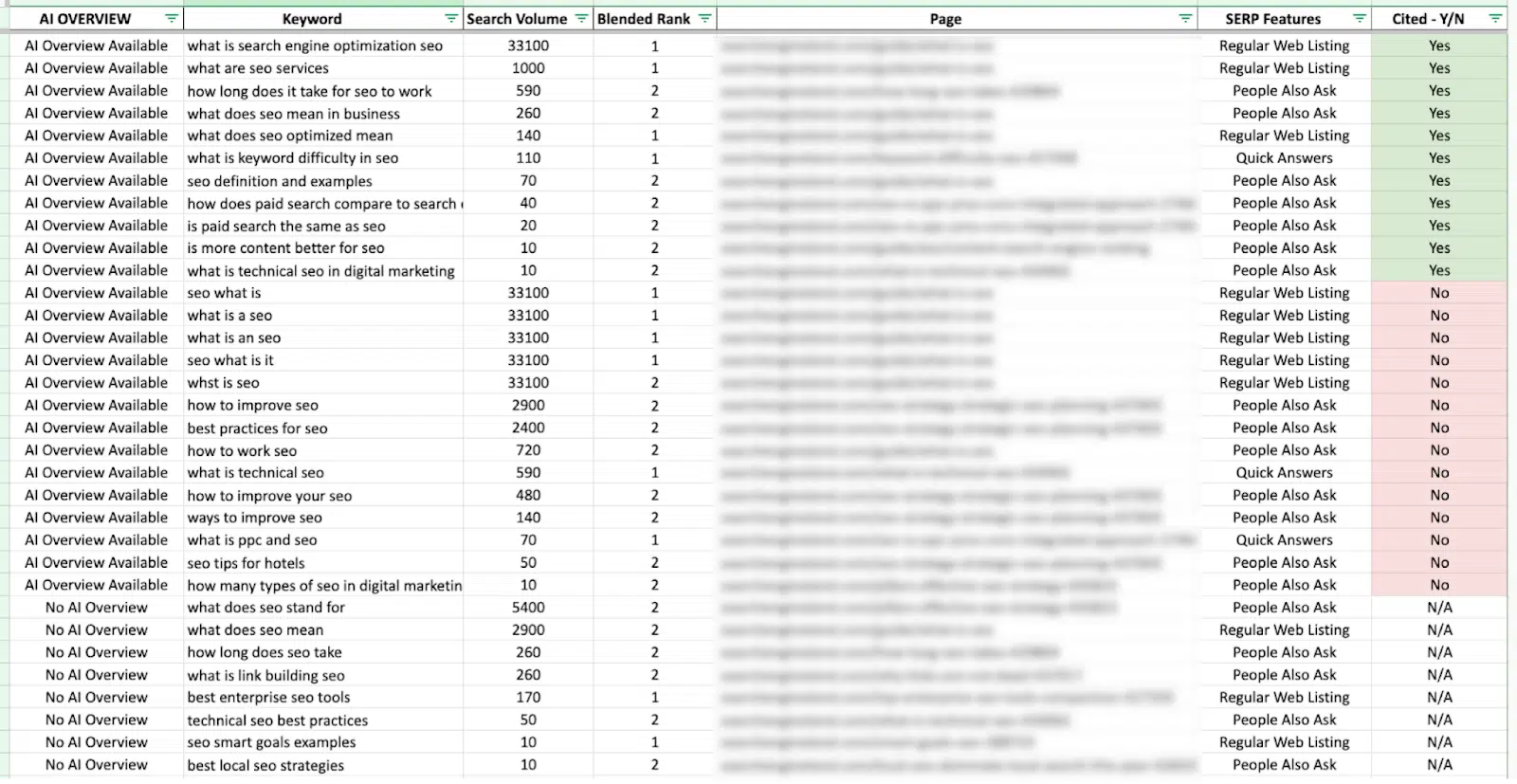

- With conditional formatting, you can easily track your brand’s placement and monitor the sources being cited.


- Analyze AI Overview response structures and content elements to:
- Optimize your content for AI Overviews, it’s essential to understand how AI structures its responses to your key queries.
- Identify the common formats – whether lists, tables or videos – and tailor your content to incorporate elements like data points, topics, multimedia and key phrases that AI deems relevant.
- Examples:
- “What is SEO” AI Overview: Begins with a concise paragraph, followed by headings and lists that cover the reasons SEO is important and ways to improve a website’s SEO performance. To increase chances of being featured, content should comprehensively address these core aspects.
- “Best digital marketing strategies for small businesses” AI Overview: Combines text, images and a bulleted list that covers specific digital marketing channels, strategies and actionable tips. If you aim to target this AI Overview, adjust your content to mention similar topics and actionable tips.
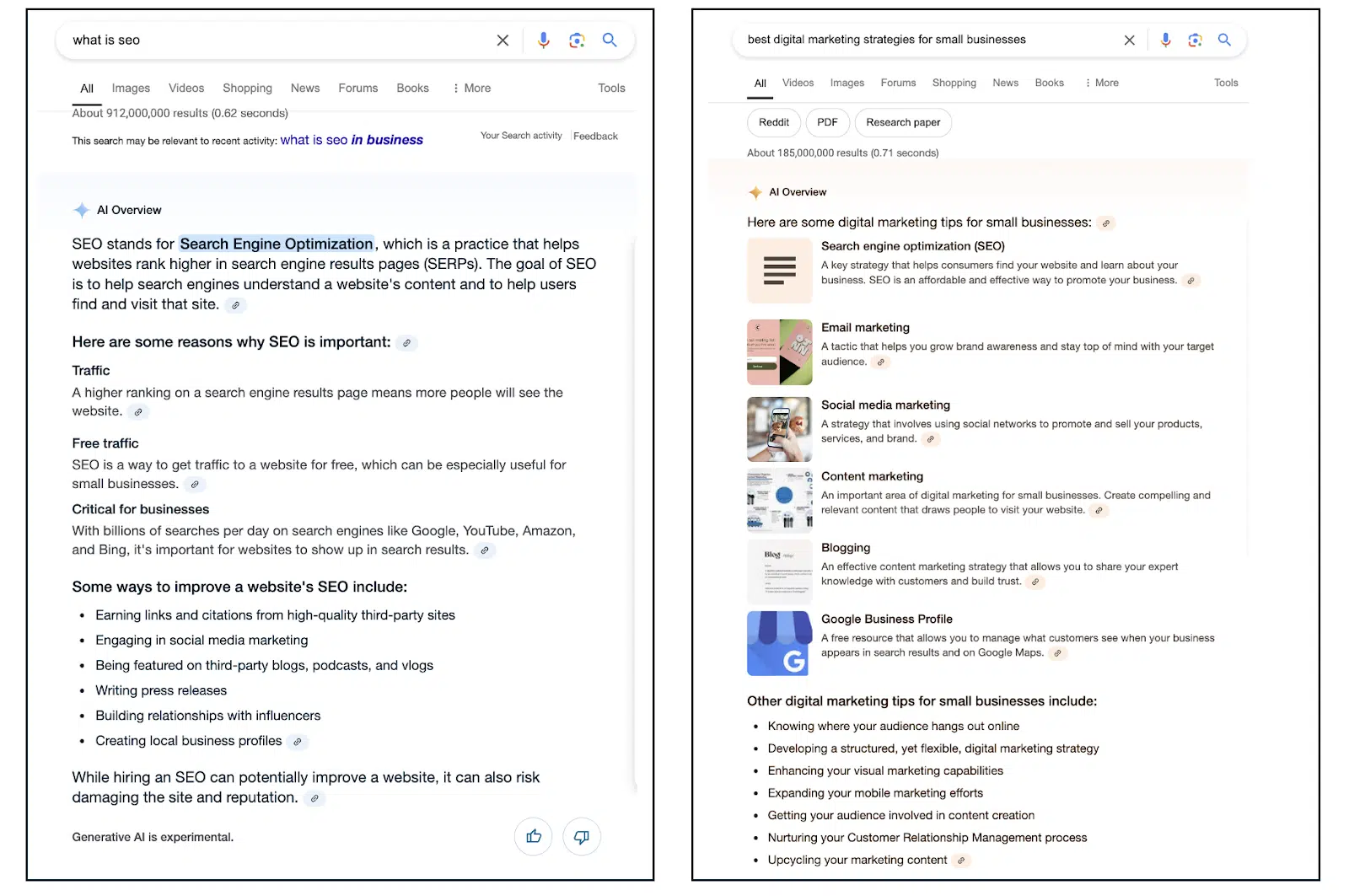

Competitor research and analysis
GEO competitor research helps you identify how competitors perform in AI-driven search results. By analyzing their successes, you can uncover effective strategies, spot content gaps and refine your approach to improve visibility and stay competitive.
This research is an opportunity to learn from those excelling in AI-driven search. Analyze how competitors are referenced, then adapt their strategies to improve your own content.
Focus on areas where you can offer more insights or add value while always showcasing your brand’s unique perspective.
Actionable tips:
- Track competitors cited by AI:
- Start by identifying competitors frequently appearing in AI-generated overviews for your target keywords.
- Use monitoring tools: Use the free tools mentioned above, like the AI Overview Impact Analysis and Citation Analysis Chrome extensions, to track competitors.
- Leverage Advanced AI Tools: Integrate tools like the ChatGPT API with Google Sheets to build custom solutions that allow you to efficiently track and analyze your brand’s visibility in AI-driven responses.
- Start by identifying competitors frequently appearing in AI-generated overviews for your target keywords.
- Monitor trends and shifts in sources cited over time:
- Stay updated on AI’s evolving content preferences, such as shifts toward newer publications or specialized sources and adjust your strategy to maintain relevance and competitiveness.
- Analyze competitors’ source content and adapt successful strategies:
- Analyze competitors’ content to uncover gaps and opportunities where you can offer more value.
- Look at both the structure and depth of their content and adapt successful strategies to improve your own.
- Evaluate structure and format: Identify the content formats competitors consistently use (e.g., lists, tables or multimedia) that AI may favor.
- Assess the depth of coverage: Determine if competitors provide comprehensive coverage of key topics or if there are gaps you can fill by expanding on neglected areas.
- Incorporate multimedia: If competitors frequently use visuals like infographics or videos, enhance your content by including similar elements to engage both AI algorithms and users.
- Adopt effective formats: Pay attention to how competitors use structures like bullet points, QandA sections or visual elements that improve AI-driven content discoverability.
- Enhance with your unique perspective: While adopting successful strategies, maintain your brand’s voice and insights to stand out from competitors.
- Example:
- For the keyword “benefits of content marketing,” if AI often references competitor content with numbered lists and visuals, consider using similar elements while incorporating your unique perspective to increase your chances of being featured.
Dig deeper: Entity-based competitor analysis: An SEO’s guide
Brand perception intelligence
Brand perception intelligence involves gathering insights from AI platforms on how both AI systems and users perceive your brand.
In an AI-driven world, brand perception and customer sentiment heavily influence search visibility. AI systems favor brands viewed as authoritative, credible and trustworthy, improving visibility and building customer trust.
Actionable tips:
- Conduct research about your brand on AI platforms:
- Regularly assess how AI platforms like ChatGPT and Perplexity portray your brand.
- Analyze AI-generated summaries, user queries and brand representation in user-generated content (UGC) to identify gaps and areas for improvement.
- Use UGC insights:
- Analyze how AI platforms use UGC to gauge customer sentiment and overall brand perception.
- Automate UGC collection and analysis with AI tools to refine your brand strategy.
- Tip: Use tailored prompts and custom-built GPT solutions to automate the collection and analysis of brand perception data.
- Example research output: Showcases a comprehensive sentiment analysis report, including key elements like general sentiment, specific aspects of product/service perception, comparisons with competitors, emotional connection and communication effectiveness.
- Why this is useful: Helps quickly assess where your brand excels and where it needs improvement. By leveraging these insights, you can make data-driven improvements to your brand’s strategy, both in terms of product/service offerings and customer communication.
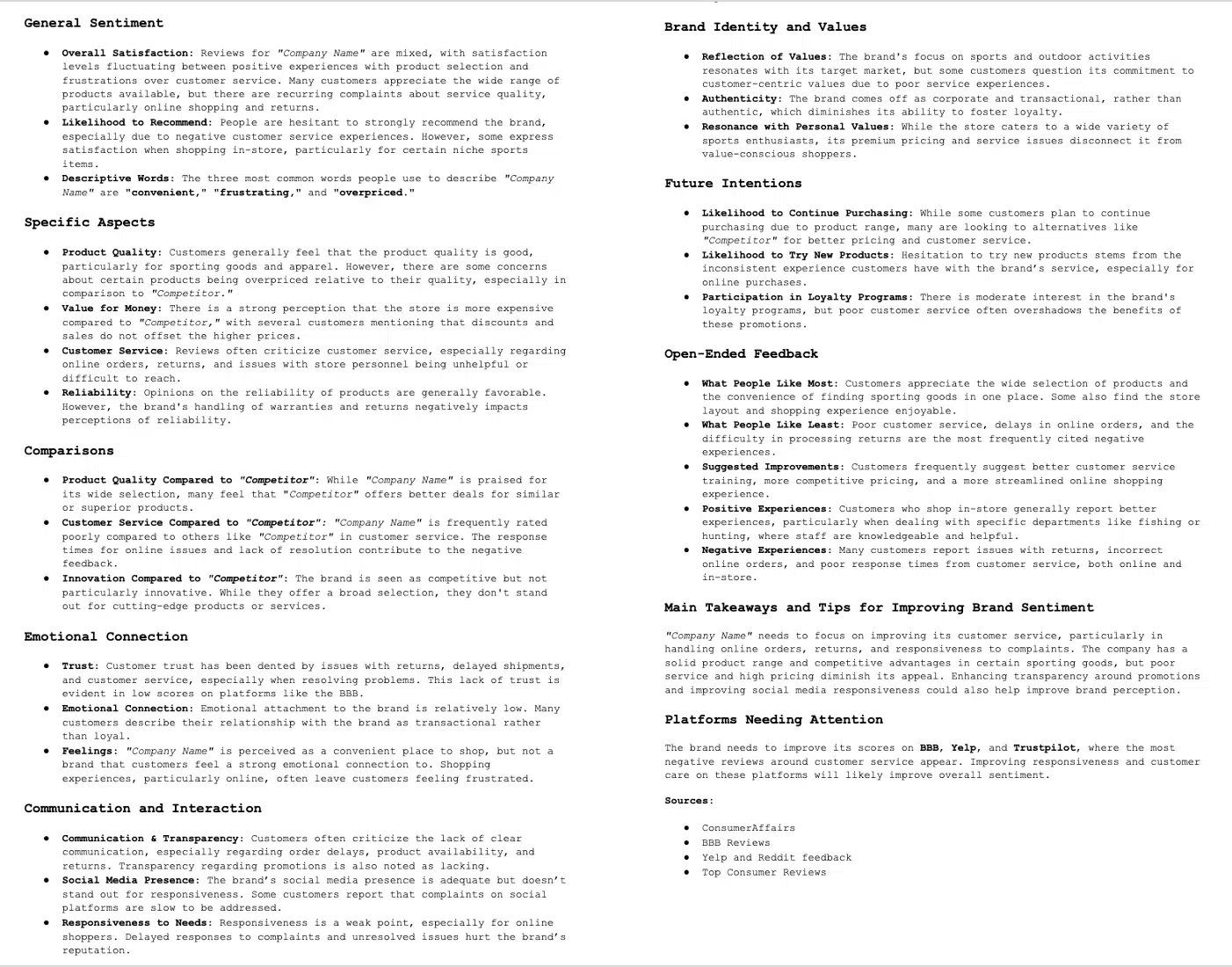

- Adapt to customer sentiment:
- Monitor AI-generated queries and responses to understand customer sentiment. Adjust your content and communication strategies to maintain a positive brand image across digital platforms.
- Monitor brand perception on AI platforms over time:
- As AI systems evolve, so will the perception of your brand. Continuously track how AI platforms represent your brand and adjust strategies to maintain a consistent and positive narrative as AI systems evolve.
- Integrate insights into your brand strategy:
- Use AI-driven insights to inform your overall content and brand strategy. Ensure consistency across all channels to enhance your brand’s perception, visibility and credibility.
- Example: If AI frequently mentions your brand in connection with specific keywords or topics, analyze these mentions to ensure they align with your desired brand image. Adjust your content strategy as needed to emphasize key aspects of your brand.
Dig deeper: How to become a recommended solution provider on Google entity lists
2. Optimizing content for generative AI
Once your research is complete, the next step is putting those insights into action by optimizing your content and applying insights to ensure your content is relevant, structured and accessible for AI systems.
Today, high-quality content alone isn’t enough. Your content must be optimized for AI algorithms to maintain visibility and authority.
Content quality and relevance
Crafting credible, contextually rich and engaging content that meets user needs is essential. By aligning your content with AI systems, you ensure it remains relevant and trusted by both AI platforms and users.
Actionable tips:
- Expand contextual relevance:
- Incorporate relevant keywords: Use long-tail, conversational and semantic keywords identified during research to optimize your content. Integrate these keywords naturally to match how users search and interact with AI-driven platforms.
- Expand related concepts: Apply insights from research to deepen your content, making it more comprehensive and valuable to users. Align with AI’s preference for in-depth content by filling market gaps and offering unique value.
- Integrate key entities and phrases: Use key entities, phrases and concepts identified during research to build a narrative that resonates with AI’s contextual algorithms, ensuring relevance and authority.
- Establish authority and credibility:
- Citations: Reference credible, up-to-date sources to validate your claims and connect your content with established research.
- Quotations: Incorporate authoritative quotes from industry experts to add depth and authority.
- Statistics: Include relevant and timely data points presented in impactful formats like graphs or charts.
- Align with E-E-A-T principles: Build websites demonstrating experience, expertise, authority and trustworthiness (E-E-A-T).
- Craft comprehensive and engaging content:
- Provide thorough, engaging and varied content that fully addresses user queries and aligns with AI preferences for diverse content types.
- Provide comprehensive responses: Offer thorough answers that fully address user queries, as AI favors in-depth content.
- Make content informative and engaging: Focus on creating content that is informative, easy to understand and provides clear, actionable insights.
- Use varied multi-modal formats: Incorporate a mix of formats – blog posts, guides, videos and interactive content – to keep your audience engaged and align with AI’s preference for diverse content.
- Maintain content freshness:
- Regularly update your content to signal to search engines that the information is current and relevant. Fresh content aligns with current trends and user interests, improving your content’s relevance.
- Example: Update a blog post on “2023 Digital Marketing Trends” to reflect the latest trends in 2024, ensuring it remains relevant, timely and more likely to be prioritized in results.
- Regularly update your content to signal to search engines that the information is current and relevant. Fresh content aligns with current trends and user interests, improving your content’s relevance.
Content structure and clarity
A well-organized, clear structure is essential for engaging users and ensuring alignment with AI.
Simplifying language, maintaining logical flow and integrating visuals make your content more accessible to both AI systems and users.
Actionable tips:
- Improve content clarity and readability:
- Simplify language: Use clear, straightforward language, avoiding jargon and complex sentences.
- Break down complex information: Use bullet points, lists and short paragraphs to make ideas more scannable and understandable.
- Highlight key information: Emphasize important points with bold text, callout boxes or summaries to ensure they stand out.
- Incorporate visuals and multimedia: Use high-quality images, infographics and other visuals to break up text and illustrate key concepts, enhancing engagement and readability.
- Consistent formatting: Maintain uniform font sizes, styles and colors across all content elements to enhance readability.
- Enable quick comprehension of your content:
- Optimize your content to make key details easily accessible, ensuring that AI and users quickly grasp the most important points.
- State what to expect: Clearly articulate the main purpose or topic at the beginning of the content.
- Summarize key points: Include brief summaries or lists of key takeaways at the top of your content and throughout relevant sections.
- Incorporate FAQ sections: Add FAQs to longer content to address common questions, increasing the likelihood of AI using it to answer specific queries.
- Deliver quick answers: Provide direct answers to queries within the first few sentences, making it easier for AI and users to find the information they need quickly.
- Example: For the query “What is Generative Engine Optimization?” AI tends to pull responses from content that provides clear, immediate answers, like those in the examples shown below. These examples use structured summaries and concise, digestible points throughout each piece, helping both AI systems and users digest the most relevant information.
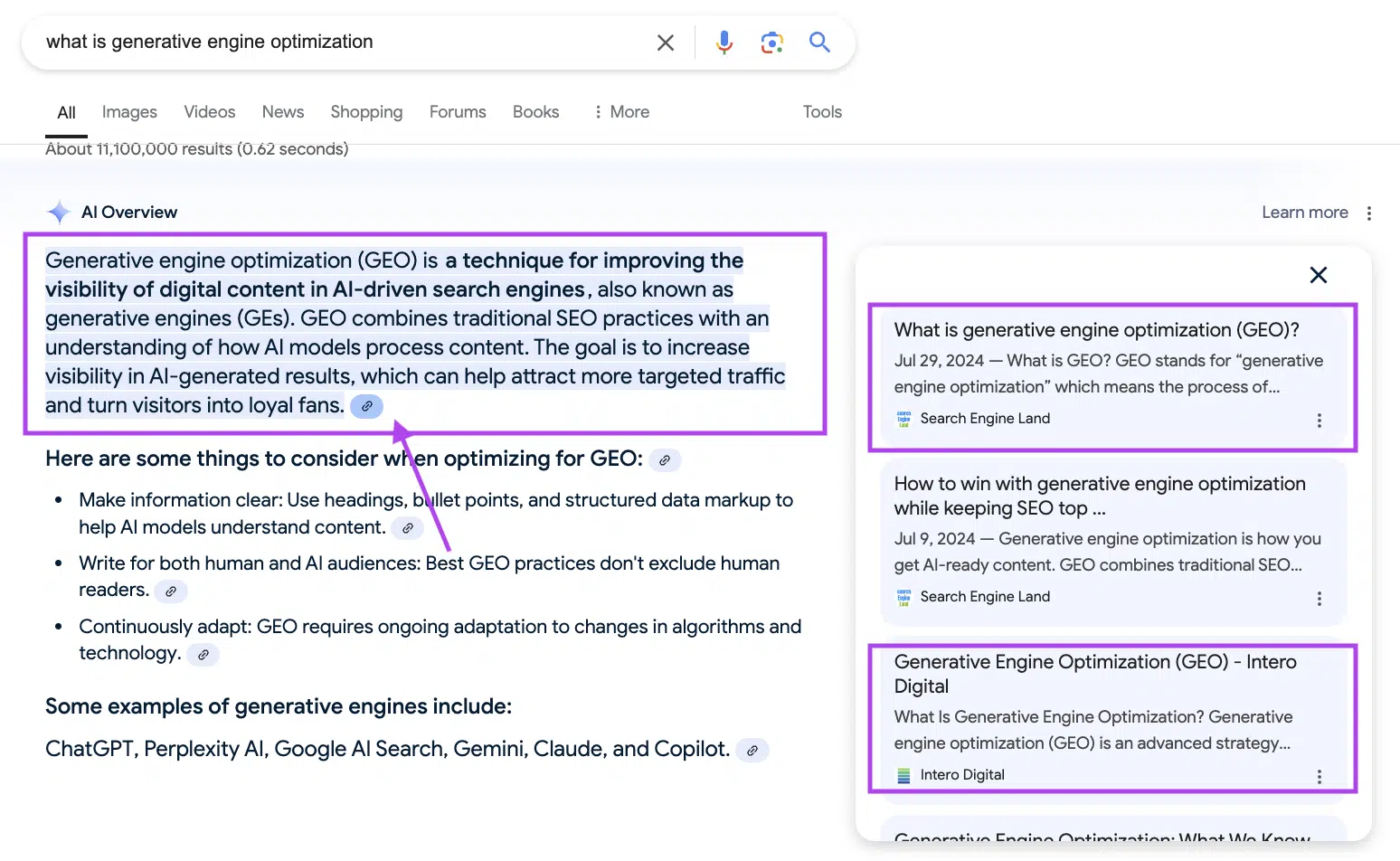

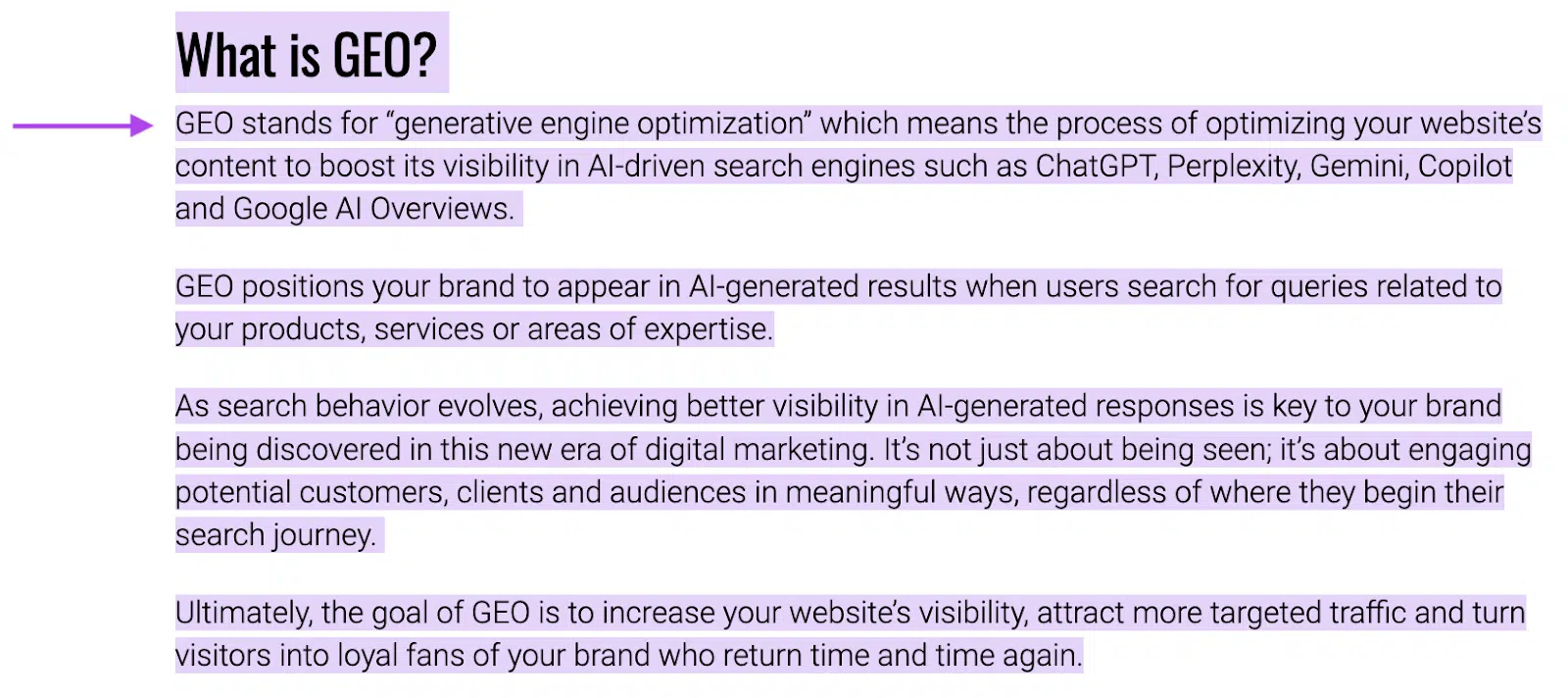

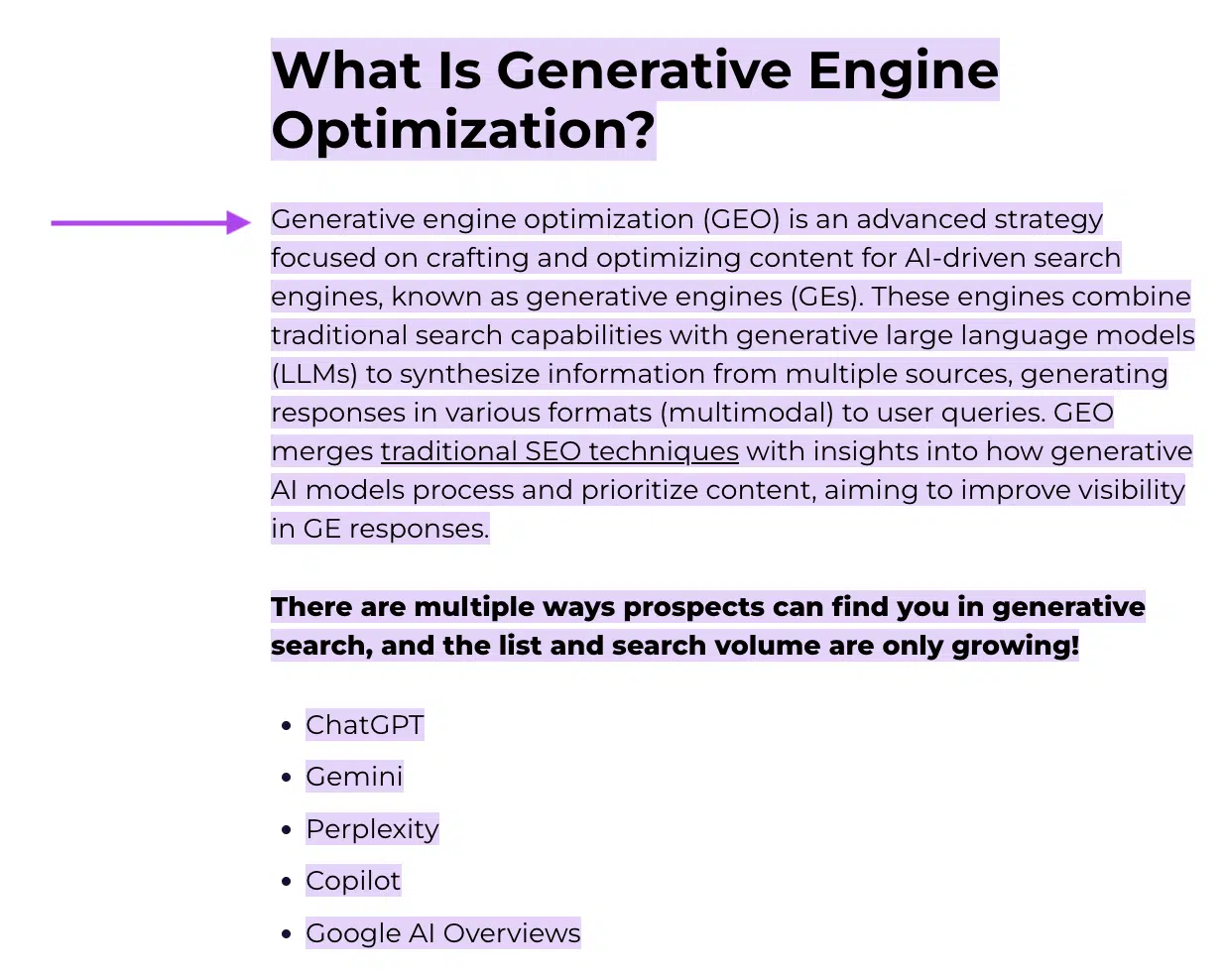

- Optimize content structure and fluidity:
- Prioritize content fluidity: Create a smooth, logical progression throughout your content. Use clear transitions and well-structured paragraphs to enhance readability and engagement.
- Use clear and descriptive headings: Organize your content with headings that logically guide readers and AI through the material.
- Design effective navigation: Create a clear hierarchical structure using H1 to H5 headings and distinct sections like FAQs or step-by-step guides to enhance usability and relevance.
- Leverage key insights from research:
- Use insights from your GEO research to enhance content structure and clarity around your key queries.
- Refine content structure and format: Adapt your content to align with trends observed in AI-generated responses and cited sources, incorporating elements like lists, tables and other effective formats.
- Emphasize key information: Incorporate common data points, topics and details that AI frequently emphasizes, filling gaps in your content.
- Integrate multimedia: Include videos, infographics or other visual elements if AI tends to favor these in its responses.
- Leverage competitor strategies: Implement content structures and formats used by top competitors frequently cited by AI for your key queries.
Dig deeper: What is content readability and how to make your content easier to read
3. Technical optimization for AI accessibility
Now that your content is well-structured and engaging, it’s crucial to ensure AI systems can easily access, interpret and prioritize it in AI-driven search.
As the digital landscape evolves, traditional SEO must adapt to meet the sophisticated needs of AI, ensuring your content is not only visible but also understood and valued by search algorithms.
Structured data for AI understanding
Think of structured data as a roadmap that helps AI navigate your content, highlighting what’s most important and ensuring it’s interpreted accurately.
By using the right schema markup, you’re not just organizing your content – you’re making it easier for AI to recognize, categorize and present it in relevant searches.
Whether optimizing for voice search, product listings or user-generated content, the appropriate schema ensures AI delivers your message to the right audience.
Actionable tips:
- Organize and structure content: Use schemas like Article, Organization and Breadcrumb to help AI understand your content’s structure and context, boosting visibility in relevant searches.
- Support natural language queries: Implement FAQ and QandA schemas to optimize for voice search and generative AI, helping AI find direct answers and increasing your content’s chances of appearing in AI-generated results and featured snippets.
- Highlight important elements: Apply schema markup to key content like products, reviews and FAQs to ensure AI recognizes and prioritizes these elements in enhanced search results.
- Boost visual content visibility: Use ImageObject and VideoObject schemas to enhance the visibility of your visual and video content. Proper markup helps AI identify and prioritize this content in search results.
- Showcase user-generated content: Implement Review, AggregateRating and Testimonial schemas to highlight user feedback, increasing your content’s credibility and visibility in AI-driven searches.
- Broaden schema application: Consider using additional schema types to help AI better understand and prioritize your content in specific contexts.
Technical SEO enhancements
Structured data is just one piece of the puzzle. A strong SEO foundation that focuses on various technical aspects is essential to ensure your site is accessible and efficient, giving AI the best possible framework to work with.
Actionable tips:
- Optimize for speed and accessibility: Ensure fast loading times, mobile-friendliness and clean code. These factors help search engines crawl and index your site efficiently, giving AI systems the data they need for generating relevant responses.
- Enhance performance: Improve server response times, optimize images and fix crawl errors or broken links. A well-performing site is more likely to be accurately indexed, which leads to better search visibility.
- Secure your site: Implement HTTPS and maintain strong security practices. AI systems prioritize secure sites, so ensuring your site is safe boosts credibility and trustworthiness.
- Streamline site architecture: Clear content hierarchy and effective internal linking help AI understand relationships between different pieces of content, improving relevance in search results.
- Prioritize mobile optimization: As mobile search dominates, ensure your content is mobile-friendly. AI favors content optimized for mobile, directly impacting your visibility.
By integrating structured data and improving your technical SEO, you create a solid foundation that allows search engines to accurately index your site. This enables AI to access, understand and prioritize your content based on the data collected.
4. Content distribution and engagement
Your content is only as powerful as the audience it reaches.
To maximize its impact, you need to strategically distribute it across multiple platforms, ensuring it resonates with different audience segments and meets the evolving demands of AI-driven systems.
The more places your content appears, the more opportunities AI has to recognize, elevate and share it, expanding your reach and influence.
Actionable tips:
- Focus on the right platforms:
- What to do: Identify 3-5 platforms where your audience is active (e.g., social media, Reddit, Quora) and tailor your content to fit each platform’s style while maintaining a consistent posting schedule.
- Why: Spreading your content across these platforms signals to AI that it’s credible and worth prioritizing. More visibility across multiple channels increases the chances of AI recognizing and elevating your content.
- Incorporate UGC:
- What to do: Encourage your audience to share their experiences with campaigns like hashtag challenges or reviews and feature the best UGC on your platforms.
- Why: User-generated content enhances your brand’s credibility by reflecting authentic user interactions, which AI systems prioritize. This authenticity boosts engagement and makes your content more appealing to both users and AI.
- Engage proactively on social media:
- What to do: Dedicate time daily to interact with your audience on social media by responding to comments, answering questions and joining conversations.
- Why: Regular engagement shows AI that your content is relevant and valued, increasing its visibility and helping you reach a wider audience.
- Create shareable content:
- What to do: Create shareable content like infographics, tips and visually appealing posts. Use clear calls to action and social sharing buttons to encourage sharing.
- Why: Shared content gains more visibility, signaling its importance to AI, which can lead to broader reach and greater influence.
- Keep content fresh and relevant:
- What to do: Regularly update top-performing content with new keywords, relevant links and fresh visuals. Repurpose and re-share it across platforms to keep it current.
- Why: AI favors content that is consistently updated and aligned with trends, keeping it relevant and visible.
By distributing content strategically and engaging with your audience actively, you significantly increase your visibility across platforms.
This ensures that both AI systems and a wider audience recognize, prioritize and interact with your content.
5. Building brand authority and credibility
In an AI-driven world, building your brand as a trusted authority means more than just creating great content. It requires a strategic approach that combines credibility, consistency and ethical practices across everything your brand does.
To truly stand out, your brand must deliver accurate, valuable information while building trust through collaborations, clear communication and a consistent brand identity.
Actionable tips:
- Build backlinks from authoritative sites: Secure backlinks from credible websites to signal trustworthiness to AI systems.
- Guest blogging: Contribute to reputable industry sites.
- Partnerships: Collaborate with trusted brands.
- Shareable content: Create content that naturally attracts high-quality backlinks.
- Use ethical content practices: AI favors content that aligns with user intent and delivers genuine value.
- Transparency: Be clear and honest, avoiding clickbait.
- User-centered approach: Create content that truly meets your audience’s needs.
- Fact-checking and accuracy: Always fact-check your content to ensure accuracy.
- Accessibility: Ensure accessibility for all users, including those with disabilities.
- Demonstrate your expertise: Consistently showcase your knowledge and insights to reinforce your authority.
- Original research: Publish unique, data-driven insights.
- Case studies: Highlight successful strategies and innovations.
- Expert opinions: Include industry experts in your content.
- Implement consistent branding: Maintain a recognizable and trustworthy identity across all platforms.
- Unified messaging: Keep your brand messaging consistent.
- Visual identity: Ensure cohesive use of logos, colors and design elements.
- Foster relationships with influencers and thought leaders: Collaborations with recognized influencers and thought leaders can significantly amplify your brand’s authority. Focus on:
- Content collaboration: Co-create content with industry influencers.
- Endorsements: Seek testimonials from respected figures.
- Guest appearances: Participate in industry podcasts and panels.
By focusing on credibility, ethical practices and consistent expertise, you can build lasting authority and trust. Aligning your brand with AI systems and maintaining a strong, cohesive identity will pave the way for long-term success.
Key takeaways for mastering GEO strategies
Adapting to AI-driven search isn’t just beneficial. It’s essential to your brand’s long-term success.
Here’s a quick recap of the actionable strategies you need to lead in this evolving landscape:
- Embrace GEO as the future of SEO: Traditional SEO is evolving. GEO ensures your brand remains visible and competitive in AI-powered search.
- Leverage AI research: Success starts with understanding how AI interprets content. Dive into semantic analysis, user intent, competitor strategies, AI-generated responses and brand perception insights to align your content with AI algorithms and position your brand as authoritative.
- Optimize content for AI prioritization: High-quality content is just the start. Structure it for AI by making it clear, relevant and designed to be prioritized in AI-driven results.
- Master technical SEO: Keep your site technically sound with structured data, fast load times and mobile optimization to ensure AI can easily access and rank your content.
- Strategically distribute and engage: Amplify your content across platforms and engage with your audience regularly. The more visible and active your content, the higher AI will prioritize it – so stay consistent and share often.
- Build and maintain brand authority: Trust is everything. Focus on securing high-quality backlinks, consistent branding and ethical, value-driven content to build credibility with both AI and users.
Take the next step
The future of search is AI-driven. By embracing GEO now, you position your brand to lead in this evolving landscape.
The strategies you implement today will ensure your success tomorrow. Get started now and future-proof your brand’s online presence.
Contributing authors are invited to create content for Search Engine Land and are chosen for their expertise and contribution to the search community. Our contributors work under the oversight of the editorial staff and contributions are checked for quality and relevance to our readers. The opinions they express are their own.
